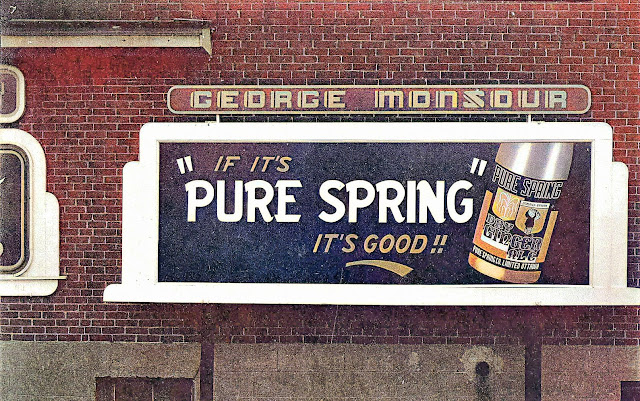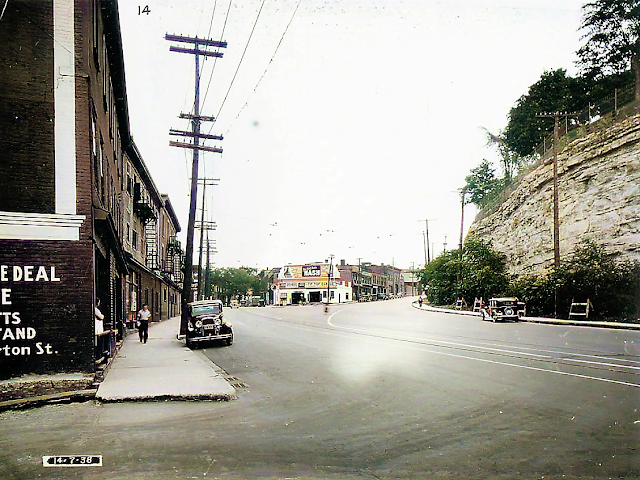Where Did Pure Spring Get Its Water? Brading's '1000-Foot' Well
 |
| Pure Spring sign, Westboro (1946). [Orig. image via Ottawa Archives – colourized by Ashley Newall] |
"Those who had occasion to visit Major's Hill Park in the early [eighteen-] nineties will probably recall the little spring that trickled down the surface of the slope at the north end of the park and formed a little pool of crystal clear water just below the foot of the locks near Stirling's brewery. There was a footpath leading down the slope of the hill at that time and dozens of people used to travel down that to get a drink from the pool." (Ottawa Citizen – Aug. 7, 1937)
Perhaps this is where Stirling’s Dominion Brewery got its water. Probably not, but it’s fun to think about given all the hullabaloo regarding the water source over at Brading’s (on the eastern edge of Lebreton Flats), which was ultimately tapped via a well dug “1000 feet below the street level.” One David Mirsky would ultimately use that Brading’s well for his Pure Spring Ginger Ale (rather than getting his water from anything remotely resembling the fantastical waterfall scene that later adorned his soda cans), a fact of which I’ve become utterly convinced.
 |
| Pure Spring clock. |
Allow me to explain.
Early in David Mirsky’s enterprising life, he found his way onto the Brading's property. As a lad, he'd return empties to the brewery for change, and when he conjured up a business idea to sell beverages, beginning with selling bottled water at a train station (with the empties, perhaps), they took him under their wing. (By ‘they’ I mean Col. Plunket B. Taylor, then-owner of Brading Breweries, and sire to future infamous magnate Edward Plunket (E.P.) Taylor, who inherited Brading's in 1944 and subsequently parlayed it into the Carling-O’Keefe behemoth.) Said business idea was no doubt tied to the ready availability of high-quality water at Brading’s.
 |
Brading Breweries, Wellington St., Ottawa (ca. 1938). [Orig. image via Library & Archives – colourized by Ashley Newall] |
“Through the kindness of Col. Plunkett Taylor, Mirsky was allowed to build a shack beside the brewery and tap the spring that flowed down the granite escarpment at the foot of Bronson Ave. Mirsky called his product Pure Spring after this special water supply.” ["Ottawa, the Capital of Canada," by Shirley E. Woods (1980)]
There was no spring that flowed down the escarpment at the foot of Bronson, at least not by that time.
 |
| Wellington St., Ottawa, viewing northerly (ca. 1938). Wellington St. cliff on right. I don't see a spring – do you see a spring? [Orig. image via Library & Archives – colourized by Ashley Newall] |
 |
| Sparks St., viewing west to Wellington (ca. 1938). Wellington St. cliff on left. I don't see a spring – do you see a spring? [Orig. image via Library & Archives – colourized by Ashley Newall] |
Shortly before Taylor the elder took over in the 1920s, a well was dug on the Brading's premises which they advertised mercilessly. It was much-ballyhooed as being “1000 feet below the street level.” (The street in question was Wellington St., back when it used to bend south at the point of the present-day Library & Archives building, instead of northwesterly towards the Portage Bridge, as it does now.) The well water emanated from a subterranean "spring" that was "pure," you see. Mirsky must have been thinking, ‘this sh*t writes itself,’ and an enduring – and locally legendary – brand was born.
 |
| [Ottawa Journal – May 7, 1918] |
(To help with your bearings, the area of the former brewery is now the "Park of the Provinces," and the brewery itself was very near Pooley’s Bridge.)
 |
| [Ottawa Journal – Dec. 10, 1915] |
Brading's (est. 1865) had dug numerous wells on their property prior, but none as big and as bad as this one. If Mirsky was going to market his water source as the greatest ever, surely then he would've been getting it from the highest quality commercial well in town, which also incidentally so happened to be on the very property where his factory resided, within the Brading’s complex.
The famous Pure Spring Ginger Ale can graphic depicts a Shangri-La, and one which certainly didn't exist on the Wellington St. cliff (aka Bronson’s Hill aka Christ Church Hill), or anywhere near, including anywhere along Nanny Goat Hill, the colloquial name for the escarpment as a whole which hugs Lebreton Flats from Booth St. to the foot of Bronson. What we have here, folks, is a brand myth, er, pure and simple.
 |
”Children on street,” Lebteton Flats, Ottawa (1963). Pure Spring sign on right; west face of Wellington St. Cliff in background. [Library & Archives] |
Many folks have gone searching for the vaunted Pure Spring spring, thought to possibly be within the old Brading’s beer cave (not to be confused with the separate beer train tunnel under Lebreton Flats). I can report that it turns out the grey stone anomaly on the North side of the 'Wellington St. cliff' is not actually an entrance to the cave nor to the Pure Spring waterfall theorized to be within, but rather it’s a decommissioned sewer vent (a fact which was conveyed to me directly by a City worker at the site). Further, the encasing was built of stone to try and blend in with the escarpment – to not be unsightly – making it that much more alluring for spring and/or cave seekers. The vent was decommissioned because Christ Church parishioners were complaining about the smell.
 |
| Decommissioned sewer vent, north face of Wellington St. Cliff, Park of the Provinces. Not an entrance to a cave &/or underground spring. (Photo by Andrew King) |
A replacement vent has been placed about 250 metres NW of the decommissioned one and disguised as sculpture. And so, everyone can stop trying to climb in that manhole atop the cliffside structure now, which I've been told by said City worker folks have been attempting for the last few years in particular, the location having been geocached. It’s hard not to imagine the look on anyone's face who may have actually defeated the high-perched manhole cover and gained access.
 |
| Brading's beer cave ad. |
And so, the Pure Spring Nanny Goat Hill myth is just that – a myth. And a very good one. Everyone loves a catchy narrative to attach to a brand. Perhaps the wily Col. Taylor taught 'ol Mirsky all about such things. It's a great story, and so convincing that – like many other myths developed for the sake of the media and marketing – it lives on. It's like Mark Twain says: “A cat has nine lives, but a lie can live on forever.”
Many Ottawa history buffs will be aware of Andrew King's writings on this very subject, and I can report that I’ve run my theory by him, and – with this new information having come to light – he’s in agreeance that Mirsky’s use of the once-famed Brading’s well is indeed the most likely scenario.
As for George Stirling’s Dominion Brewery water source, it was more likely the Ottawa River.
Update (Aug. 26, 2025): I've just discovered two newspaper clippings that bolster my thesis.
The key quote in the first clipping is, "As sales increased, the business was moved to a site next to Brading's Brewery and arrangements were made to use the pure water that flowed from the brewery springs, thus bringing into being the name "Pure Spring."" [Ottawa Journal – June 14, 1969]
 |
| Ottawa Journal – June 14, 1969 |
(It's worth noting that there was never any mention of Brading's using above-ground springs – all their springs were located underground, and were consequently only accessed via wells.)
The second clipping points to the springs being located behind the brewery (which by then was brewing O'Keefe's, the Brading's Brewery having moved west to the south-west corner of Wellington (now Albert) and Preston streets, on the southern edge of Lebreton Flats). (This new Brading's location was the one with the now-infamous underground train running beneath the gigantic beer warehouse on the opposite/north side of then-Wellington.)
 |
| Ottawa Citizen – March 12, 1962 |
Immediately in front of the (originally Brading's, and ultimately O'Keefe's) brewery (i.e. on the eastern edge of Lebreton Flats) were the street and sidewalk [see "Brading Breweries" pic above], and so the springs could only have been located behind. The brewery backed onto a gorge, and so some of the wells were indoobitably dug into the gorge cliff wall.
All of this further bolsters my thesis, since it's confirmed in both clippings that Pure Spring indeed used Brading's springs (all of which were underground, accessed via wells).
You can follow my Capital History Ottawa on Twitter/X &/or Instagram.


%20from%20Government%20Hill,%201855.jpg)

,%201829-1900%20-%20banner.jpg)